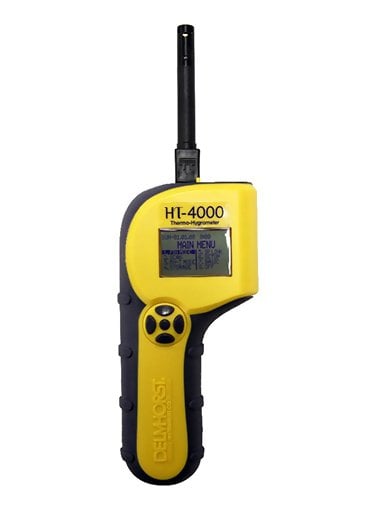
Bright, clear digital display.
Relative Humidity Range: 0% - 100%, sensor can be used for in-situ concrete testing following the ASTM F2170 standard
Temperature Range: -40F - 255F (-40C - 124C).
The Delmhorst HT-4000F moisture meter is a stand-alone thermo-hygrometer for flooring installers and inspectors. The meters detachable sensor makes the Delmhorst HT-4000F moisture meter ideal for testing a concrete slab according to the ASTM F2170 standard. It has the same fast acclimating RH/T sensor found in our popular TotalCheck 3-in-1 moisture meter. For flooring contractors who prefer having separate meters to one combination meter, the HT-4000F is the perfect solution

Kit Contents

- Delmhorst HT-4000F Thermo-Hygrometer
- RH/T-S3 Sensors - Detachable relative humidity/temperature sensor
- RH/T-C1 Cable for Easy Reading While Sensor is in Concrete
- CS-3 Concrete Sleeves for Testing in Multiple sites (10 - ten)
- Carrying Case
- Instructions
| 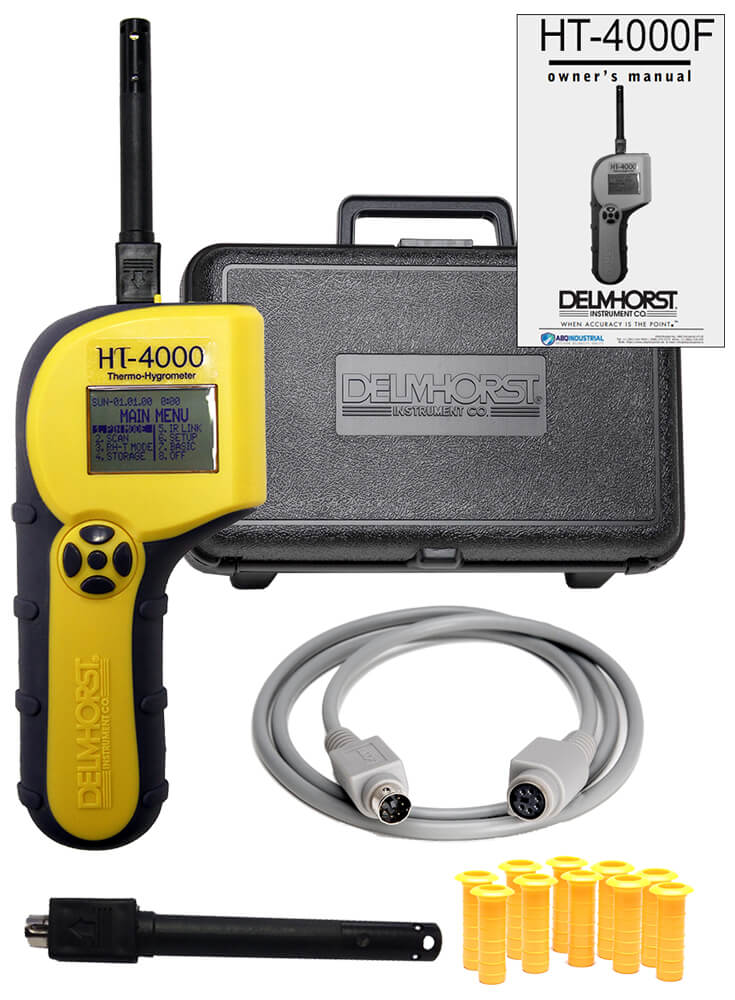 |

Features

- Bright, clear digital display.
- Relative Humidity Range: 0% - 100%, sensor can be used for in-situ concrete testing following the ASTM F2170 standard
- Temperature Range: -40F - 255F (-40C - 124C).
- Dew Point Range: -40F - 176F (-40C - 80C).
- GPP Range: 0.1 - 3820 GPP (Grains Per Pound).
- GPK Range: 0.01 - 545 GPK (Grains Per Kilogram).
- Vapor Pressure Range: 0 - 7 PSI (Pounds Per Square Inch).
- Vapor Pressure Range: 0 - 47 KPA (Kilopascals).
- Built-in back-light makes reading in dark places a cinch.
- Auto shut-off timer saves battery life.
- Reading HOLD Feature.
- Size: 8 x 3 3/8 x 1 .
- Weight: 11 oz.
- Rugged construction ensures years of reliable use.
- Sturdy plastic carrying case.
- 9V battery.
- 1-year warranty.

Accessories

CS-3 - Plastic sleeve required when performing ASTM F-2170 tests on concrete. Used with the RH/T-S3 attachment included withTotal Check and HT-4000F.Order in packs of 20 CS-3/20
|  |

Relative Humidity Test Kit The relative humidity test kit is great for testing the accuracy of our detachable RH/T-S1 and RH/T-S3 relative humidity sensors. The air inside the test kit bottle is controlled by a salt solution, which keeps the relative humidity constant. The kit is available with either 33% or 75% relative humidity (Order asRH/TK/33andRH/TK/75respectively).
| 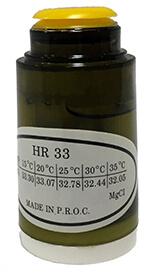 |

RH/T-C1 - Extension cable that connects to the RH/T-S3, allowing you to easily view your meters screen while performing ASTM F-2170 tests on concrete.
|  |

RH/T-S3 |  |

Downloads

 F.A.Q.
F.A.Q.
BUILDING INSPECTION:
Why should i use a Moisture Meter
Home Inspectors, Pest Control Operators and EIFS inspectors know that Moisture intrusion is the single most important factor affecting the integrity of building structures. Delmhorst Instrument Company offers Moisture Meter packages specifically manufactured to meet the needs of inspectors. Proper use of a Moisture Meter allows the inspector to easily identify the source of Moisture and to locate areas in the building that have been affected by moisture.
How does a Moisture Meter work
There are two types of Moisture Meters typically used by the home inspector. Pin-type Meters, which utilize the principle of electrical resistance, use wood or other hygroscopic materials as an element in a circuit by driving two pins or electrodes into it.
Pinless Meters use radio frequency signals to penetrate the material being tested. There is no pin intrusion into the surface of the material you are checking.
Can i use a Moisture Meter to check for pest infestation
Yes -- a few Meter readings in key locations of the structure will quickly indicate if the areas are safe or in danger of infestation. We recommend using pin-type Meters for pest control applications as the best way to identify the exact point of infestation behind walls and ceilings. The key to finding hidden Moisture is to use an electrode with insulated contact pins. These pins read only at their un-insulated pin tips, allowing the contractor to drive the pins into material at different depths, noting readings at each level of penetration.
A pinless Meter is a good way to identify infested areas, as long as you do not have to penetrate into a hidden material.
At what level of Moisture does infestation or decay occur
Wood technologists and pest control experts agree that most fungi need at least 20% MC. Readings higher then 20% is susceptible to mold growth and decay. Readings in the 17%-20% are borderline and normally require further testing. On the other hand infestation can occur at much lower levels, especially in humid conditions. Old House Borer and Powderpost Beetles can attack wood that falls in the 12-13% range.
Which type of Moisture Meter works best for EIFS
To quickly identify wet areas, a pinless Meter is easy to use. Pinless Meters offer the convenience of testing a large area quickly, and help you determine if further testing is required in certain spots.
Pinless Meters read Moisture closest to the source of the magnetic field, in this case, at the surface. Most pin-less Meters read at a depth from 1/2" to 1". Moisture that resides in the substrate or insulation may go undetected without using a deep penetrating electrode. It is also important to remember that any metal or other conductive material behind the EIFS may give false readings.
A pin type Meter, on the other hand, is the best way to identify the exact location of Moisture in the substrate and framing. A pin-type uses two pins that penetrate into the building at the users desired depth. When insulated contact pins are used, only the uncoated tips are exposed to the wood fiber, providing an accurate reading of Moisture content at various levels of penetration. Pin-type Meters are the only instruments that allow the inspector to identify exact location of Moisture at a given point.
Many EIFS inspectors use both types of Meters. They can quickly identify problem areas using a pin-less Meter, and also use a pin-type Meter to identify exact location of Moisture in the wood substrate.
Where does most Moisture intrusion occur in eifs clad houses
Most Moisture intrusion occurs around windows, doors and any flashing. In many cases the Moisture intrusion is directly related to poor installation practices.
How can i find Moisture in the substrate or frame of the house.
The most effective way to check for Moisture in the substrate or frame is to us our 21-E electrode with 6" penetration pins. This method allows you to locate Moisture behind the EIFS without it having to be torn away.
How Do I Keep a Delmhorst Meter in Good Working Condition
Delmhorst Moisture Meters are well known for their ruggedness and ability to withstand years of rough handling. Like any testing instrument, a little care goes a long way toward trouble-free service:
- Store the Meter in clean, dry place
- Change batteries and pins as needed
- Keep the Meter and electrode clean by using any biodegradable cleanser sparingly on external parts only.
If you have any doubt about the working condition of your Meter, send it to Delmhorst. We can repair and re-calibrate your instrument to its original standards and return it to you quickly.
FLOORING & WOOD PRODUCTS:
Why should i use a Moisture Meter
Structurally sound and beautiful in appearance, wood is the ideal raw material. Flooring professionals know that Moisture content is the single most important factor affecting the quality of a wood flooring installation.
To ensure quality from the manufacturer to the final installation, Delmhorst offers a full range of Moisture Meters that help minimize defects such as shrinkage, cracks, and splits. Years of experience, high-tech tools and controls, and premium grade wood cannot make a difference if Moisture content goes unchecked.
How does a Moisture Meter work
There are two types of Moisture Meters typically used in the flooring industry. Pin-type Meters, which utilize the principle of electrical resistance, use wood or other hygroscopic materials as an element in a circuit by driving two pins or electrodes into it.
Pinless Meters use radio frequency signals to penetrate the material being tested. There is no pin intrusion into the surface of the material you are checking.
Which type of Moisture Meter works best for a flooring job
To quickly identify wet areas in floors, pinless Meters are easy to use. They offer the convenience of testing a large area quickly, and help you determine if further testing is required in certain spots. A pinless Meter may also be used to determine if water-born finishes are dry and ready for a second application.
A pin type Meter, on the other hand, is the best way to identify the exact location of Moisture in sub-floors. The key to finding hidden Moisture is to use an electrode with insulated contact pins. These pins read only at their un-insulated pin tips, allowing the contractor to drive the pins into the floor and through to the sub-floor, noting readings at each level of penetration.
What are the ideal Moisture conditions for the sub-floor and wood flooring so problems can be avoided
Flooring strips or planks - and the sub-floor - should be brought to equilibrium before installation. Best results are obtained when the wood sub-floor is within 4% MC of the flooring, maximum.
If the floor is on concrete, especially a slab on grade, the challenge is to be sure that the slab is dry and not likely to pick up Moisture later on. Please refer to the Operating Instructions section under PRODUCT SUPPORT for more info.
Why doesn't the Meter give Moisture content in percent on concrete
Because the exact makeup of concrete is usually unknown, it is virtually impossible to provide a %MC calibration. Delmhorst Moisture Meters feature a 0-100 reference scale that provides dry to wet indications of the presence of Moisture. Factors that affect concrete Moisture readings include it's mix ratio and type, voids, and depth that the pin penetrates.
How does static electricity affect Meter readings
In cold and/or dry climates, static charges may cause erratic Meter readings in the range below 8 percent. Measuring such high resistance under these conditions is difficult enough, but the winter months can make it more so. The analog Meter pointer "jumps" all over the scale or the digital display may flash erratic numbers. To minimize the effect of static:
- Try not to let the electrode cable dangle.
- Drive the electrode pins into the wood with the Meter turned off, and then turn the Meter on when you are ready to take the reading.
- After driving the pins, place your hands next to them on each side of the electrode to help discharge the static from the board.
- You can also try passing a damp cloth over the board's surface to pick up any static charges before driving the pins.
These suggestions are not guaranteed. However, depending on the conditions, any one of them can work, either alone or in combination with another.
Are there board width limitations in using Moisture Meters
Board width is not a limiting factor when using a pin type Moisture Meter. As long as the pins make good contact, the Meter can be used on anything from small dowels to wide planks.
For accurate results with a pinless Meter, the material you're testing must be at least the width of the scanning area on the bottom of the Meter. Otherwise the Meter will not make firm contact with the board and may provide inconsistent, unreliable readings.
How Do Delmhorst Meters Handle Readings on Rough-Surfaced Lumber and Cupped Boards
With a pin-type Meter, these conditions are not a problem. Just drive the pins as you would normally, insuring firm, positive contact and detect unknown gradients.
Pinless Meters, however, need firm contact to a flat surface so their readings on uneven surfaces may be unreliable.
How do i determine if the Moisture problem is in the finished floor or the sub floor
In order to find this out, you must use a pin type Meter with insulated contact pins. First, take several readings in the layer just below the surface; then make a series of core readings, closer to the center of the board thickness. After you have noted these readings, hammer the pins through the flooring material until you make contact with the sub floor.
If your readings throughout this process are uniform, then there is not a Moisture problem. If readings increase as you go further into the floor, and again in the sub floor, this indicates that the sub floor is a source of Moisture.
How does temperature affect the accuracy of Meter readings
After Moisture content and a Moisture gradient, if one exists, wood temperature is the most important factor affecting the accuracy of your readings. As wood temperature increases its electrical resistance decreases and indicated Moisture content rises. The lower the temperature, the lower the indicated Moisture content. Depending on the temperature and Moisture content, you may have to make a correction.
Does the glue used in plywood affect Meter accuracy
In most cases, no. To verify this, use insulated pin to make individual tests by touching the outer ply, glue lines, and center plys. If the glue reads the same as wood, use the Meter on plywood as you would any solid material and take the readings at face value, without species correction.
How Do I Keep a Delmhorst Meter in Good Working Condition
Delmhorst moisture meters are well known for their ruggedness and ability to withstand years of rough handling. Like any testing instrument, a little care goes a long way toward trouble-free service:
- Store the meter in clean, dry place
- Change batteries and pins as needed
- Keep the meter and electrode clean by using any biodegradable cleanser sparingly on external parts only.
If you have any further questions on using a moisture meter for flooring applications
RESTORATION:
Why should I use a moisture meter for a water-damaged structure
The only way to be sure you are properly drying a structure after water damage is to monitor the drying process with a moisture meter. Even if you have the most advanced drying equipment, you cannot be sure they are working effectively without the use of a moisture meter.
How does a moisture meter work
There are two types of moisture meters typically used in the restoration industry. Pin-type meters, which utilize the principle of electrical resistance, use wood or other hygroscopic materials as an element in a circuit by driving two pins or electrodes into it.
Pinless meters use radio frequency signals to penetrate the material being tested. There is no pin intrusion into the surface of the material you are checking.
What type of meter works best for water-damaged structures
To quickly identify wet areas in walls and floors, pinless meters are easy to use. They offer the convenience of testing a large area quickly, and help you determine if further testing is required in certain spots.
A pin type meter, on the other hand, is the best way to identify the exact location of water damage behind walls, in sub-floors, or in any other area where moisture may be hidden behind another surface. The key to finding hidden moisture is to use an electrode with insulated contact pins. These pins read only at their un-insulated pin tips, allowing the contractor to drive the pins into material at various depths, noting readings at each level of penetration.
When do I check the moisture of a structure
As soon as you arrive at a job-site. It is crucial to check moisture levels in both water-damaged areas and areas that were not exposed to water. This enables you to establish a benchmark or target moisture level to reach at the end of the drying process. Use the meter continuously while drying, to confirm the progress of your work, and again before signing off. Remember, without a moisture meter, you have no way of knowing that you have dried the structure properly to "pre-loss" conditions.
What areas of a structure can be monitored using a moisture meter
Check any area that has been exposed to water damage, namely wood floors, sub-floor, joists, studs or paneling. Also check for moisture in concrete sub-floors, drywall, insulation and behind trim and moldings.
Because Delmhorst moisture meters have different scales to measure %MC in wood, gypsum, and other non-wood building materials, it's easy to check all these areas with one moisture meter.
How can I check moisture levels behind baseboards and trim molding without removing them
Use our 19-E/ST electrode. The flat blades of this electrode can be slid easily between the wall and trim, making it easy to check these hard to reach places, while leaving everything in tact.
WOODWORKING, INDUSTRIAL & MILL:
Why should i use a moisture meter
Structurally sound and beautiful in appearance, wood is the ideal raw material. Delmhorst customers in the woodworking/lumber industry know that moisture content is the single most important factor affecting the quality of their products.
To ensure quality, from the mill and dry kiln to the finishing floor, Delmhorst moisture meters help minimize defects such as shrinkage, cracks, and splits. Years of experience, high-tech tools and controls, and premium grade lumber cannot make a difference if moisture content goes unchecked.
Are there different types of moisture meters
There are two types of moisture meters commonly used in lumber and woodworking applications.
A pin-type uses two pins that penetrate into wood at the users desired depth. Pin-type meters are the only instruments that indicate the moisture conditions inside a board or a piece of wood. Using insulated pins, only the uncoated tips are exposed to the wood fiber, providing more accurate readings of moisture content at various levels of penetration. Using a pin type meter with insulated pins is still the most effective method to determine moisture gradient, which is the difference between shell and core moisture content.
Pinless moisture meters read moisture closest to the source of the magnetic field, in this case, at the surface. For quickly scanning finished product, a pin-less meter is a convenient way to identify a problem area. However, a pinless meter cannot differentiate between shell and core moisture content and will not detect a moisture gradient. Also, readings provided by a pinless meters are affected by surface moisture.
Please refer to the diagram below for a basic look at the difference between readings obtained from a pin-type meter compared to a surface meter.
| This diagram illustrates that pin-type meters and surface meters provide different information about the moisture content in a board. Each technology may be appropriate for different applications. Before choosing a meter, it is important to understand these differences in readings and choose the type of meter best suited for your particular application. | 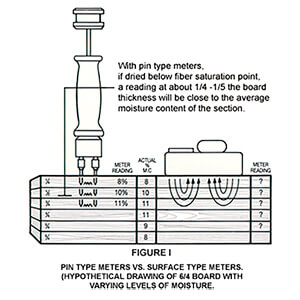 |
How does a moisture meter work
Using the principle of electrical resistance, pin-type meters use the board as an element in a circuit by driving two pins or electrodes into it. This method works because moisture conducts electricity well and dry wood is an effective insulator.
Most pinless meters use the capacitance method, which uses the relationship between the moisture content and the dielectric properties of the wood.
Both the resistance and the dielectric properties of wood change in direct proportion to its moisture content, within a specific range.
In what range of moisture content do pin-type meters operate
Resistance-type meters express moisture content as a percentage of the oven-dry weight of the wood. These meters work best from the range of fiber saturation point (25 to 30 percent) down to around 6 percent. Below 6 percent, it's tough to make accurate, repeatable readings because of the high electrical resistance in really dry wood. This is particulary true at low relative humidity levels, generally below 30 percent.
Electrical accuracy of all Delmhorst meters is better than 0.5 percent between 6 and 12 percent moisture content; better than 1 percent between 12 and 20 percent moisture content; and better than 2 percent between 20 and 30 percent, or at fiber saturation point. You can check accuracy either through the internal check or with a Moisture Content Standard.
At what moisture content level do i minimize defects
| Acceptable moisture content depends on the final use of the wood. Wood for fine furniture should be dried to 6 to 8 percent in most areas of the country, with very little variation among pieces and between the shell and core. | 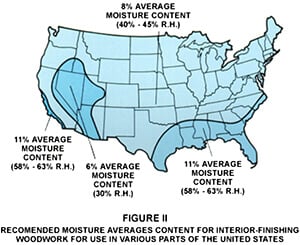 |
| Appropriate moisture content is also climate-driven. To determine the attainable moisture content - or equilibrium moisture content (EMC) - in your part of the country, hang small, thin samples of a wood species in your shop or plant and taking daily readings. When the samples' moisture content remains constant, they have reached the equilibrium level. This level will change from season to season, but you'll know the range within which to work. (Figure III) | 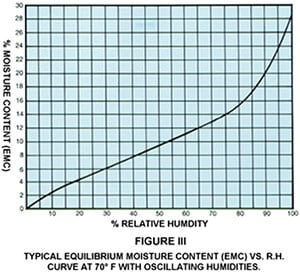 |
How do i determine the distribution of moisture in a board
Here's where Delmhorst recommends the use of a pin-type moisture meter.
First, to determine how the moisture is moving through a board, make a series of shell readings in the layer just below the surface; then make a series of core readings, closer to the center of the board thickness. The Delmhorst 26-ES electrode with insulated pins is the easiest and surest way to detect a moisture gradient.
Since the 26-E pinpoints are not insulated, two or three quick readings at different levels of penetration will indicate if the board is well seasoned, or properly dried. A normal gradient usually develops from the wetter core to the drier surface, with an average reading at between 1/4 to 1/5 of the board thickness. Even non-insulated pins, which measure the wettest fibers, will provide a good indication of how the wood is drying.
If you are using non-insulated pins, push the pins just about 1/16" into the surface, read the meter, and then push the pins to their full depth. For kiln-dried stock, the final reading should be between 6 and 12 percent; with your first reading about 1 percent lower. For air-dried stock, the final reading is typically between 12 and 19 percent, with the first reading between 2 and 3 percent lower. Meter readings outside of these ranges indicate that the board is poorly seasoned.
Pin-less meters scan through the cross section of a board taking into account the moisture in the entire penetrated area. If there is a high concentration of moisture at the surface, the reading will be skewed to reflect this surface moisture. If the surface is dry and core moisture exists, the readings will be lower than the representative moisture levels throughout the board.
Does surface moisture skew a delmhorst meter reading
Moisture caused by exposure to rain, fog or high relative humidity is easily and accurately detected with insulated pins.
If you're using non-insulated pins, push them 1/16" into the wood and read the meter. Then push them to their full penetration. The meter reading should increase by 1 to 2 points, just because of the greater contact. If there is no increase, or the increase is less than 1 percent, the wood is wet on the surface and the readings are unreliable.
As described in the answer to the question above, readings taken with a surface meter are affected by surface moisture, making it difficult to determine if the surface moisture is a result of standing water caused by rain, or if it is representative of the moisture content throughout the board.
How many measurements does delmhorst recommend for an accurate sampling
Accuracy of the readings depends on how representative the samples are of the entire load. In an ideal situation, when all the boards in a load have the same moisture content, and the distribution in each board is uniform, only a few readings are needed.
But since this ideal condition doesn't often happen, start by checking a large percentage of pieces. If the readings are within close range, it's apparent that the load is fairly uniform. For critical use, check 5 or 10 percent of the load, and be sure to look at boards from all parts of the load. Check slower drying quarter sawn boards as well as flat sawn lumber. If you can only drive pins into the edge, be sure to use the longest pins available to reach the fibers as deep as the board is thick.
The Delmhorst RDM series moisture meters with data collection and statistical analysis capabilities are ideal for simplifying the entire sampling procedure and providing backup documentation.
How far should i drive non-insulated pins into wood
To full depth if possible. However, at moisture levels below 10%, it is usually sufficient to make good, positive contact with the wood. At higher levels of moisture and especially if you have a steep gradient, full penetration is a must. Otherwise you can have discrepancies between meter readings and actual moisture content of as much as 5 or 6 points, especially in the range above 20 percent. For best results in such cases, use insulated pins.
Do i get the same reading if i use 2-pin insulated or 4-pin non-insulated electrodes
The original Delmhorst calibration was developed with a 4-pin electrode - four non-insulated steel needles, with 5/16" penetration - in samples with uniform moisture distribution. For greatest accuracy, a small correction is necessary when using electrodes with two insulated pins. The latest Delmhorst models available are calibrated either for the 2-pin electrode only, or are programmable for both 2-pin and 4-pin electrodes.
How does temperature affect the accuracy of meter readings
After moisture content and a moisture gradient, if one exists, wood temperature is the most important factor affecting the accuracy of your readings. As wood temperature increases its electrical resistance decreases and indicated moisture content rises. The lower the temperature, the lower the indicated moisture content. Depending on the temperature and moisture content, you may have to make a correction.
Delmhorst meters are calibrated at 70 F (20 C). In field use, no correction is necessary if the wood temperature is between 50 F and 90 F. If the temperature correction is not built in the meter, use the slide rule or chart we supply with each meter.
The temperature of the wood does not affect pin-less type meters, unless the lumber is frozen.
Are delmhorst meters accurate on frozen lumber
As long as the wood is not frozen solid and remains conductive, a pin-type meter will give reliable readings. However, most instrumentation, unless specifically designed for extreme weather conditions, will not work well in constant sub-freezing temperatures.
How do delmhorst meters correct for species variation
When using a pin-type meter, all species yield different readings at the same moisture content. This is due to the fact that the electrical characteristics of different wood species vary. Delmhorst uses the USDA standard - Douglas Fir - as the basis for all calibrations.
When using a Delmhorst meter on other species, either refer to the species correction chart, or key in your species into one of our microprocessor-based meters for an automatic correction.
Pinless meters also yield different readings for different species. However, instead of electrical characteristics affecting the readings, wood density affects the readings. Refer to the species correction chart enclosed with your meter to adjust the readings accordingly.
Does a group species correction provide an accurate meter reading
Species corrections are most accurate when handled as an individual correction, either through the a species correction chart, or automatically, through software. While not as accurate as individual corrections, the group correction is adequate for practical purposes, as long as the correction is close to the individual factor for the species.
What about exotic species or other species not on the charts
If the species correction is simply not available, you can take readings below 10 percent at face value. Any correction is so small that depending on the application; a correction may not be necessary.
A good moisture meter is still valuable, even without a correction factor because you can use it to determine the equilibrium moisture content (EMC). A meter reading by itself is not always as important as allowing the wood to attain its EMC level where it won't change dimension, crack, or split.
Does the glue used in plywood affect meter accuracy
In most cases, no. To verify this, use insulated pins to make individual tests by touching the outer ply, glue lines, and center plys. If the glue reads the same as wood, use the meter on plywood as you would any solid material and take the readings at face value, without species correction.
What about the chemicals in treated lumber
Recent studies have shown that you can use a Delmhorst meter with confidence at the treating plant, job site, or when the wood is in service if the preservative is a "C oxide" formulation (CCA-C) widely used today. Our experience has shown that at higher moisture content levels (above 20 percent), chemically treated lumber tends to yield somewhat erratic readings.
What about particleboard and other manufactured materials
Chemical additives may or may not affect meter readings. Use the meter to make qualitative, comparative readings. If greater accuracy is required, Delmhorst can help you to develop a specific calibration.
How do delmhorst meters handle readings on rough-surfaced lumber and cupped boards
With a pin-type meter, these conditions are not a problem. Just drive the pins as you would normally, insuring firm, positive contact and detect unknown gradients. Pin-less meters, however, need full exposure to a flat surface so their readings on some uneven surfaces may be unreliable.
Are there board width limitations in using moisture meters
Board width is not a limiting factor when using a pin type moisture meter. As long as the pins make good contact, the meter can be used on anything from small dowels to wide planks.
For accurate results with a pinless meter, the material you're testing must be at least the width of the scanning area on the bottom of the meter.
What happens if i bring a delmhorst meter into a dry kiln
Moisture meters, like most precision instruments, are sensitive to moisture. We do not recommend taking a meter into a kiln, especially from cold surroundings. If you must, take a few minutes to warm up the meter and electrode to a maximum 100F, so that the higher temperature and moisture levels in the kiln will not affect the meter for a few minutes. If you don't acclimate the meter, readings will be erratic at best.
While Delmhorst meters are built for the harsh mill environment, continued exposure to high heat and humidity will invite corrosion and shorten the life of a meter's keypad, display and PC board components.
How can i monitor moisture content during drying without going into the kiln
Use the Delmhorst Kil-Mo-Trol, a remote probe system that measures the moisture content of lumber during the drying process. Resistance probes or contact pins are located at various "stations" throughout the lumber packages to monitor shell and core or core only moisture content readings. This technique is proven for both hardwood and softwood drying, and can be used in any type of dry kiln, pre-dryer, or air-drying operation. For more information about Kil-Mo-Trol, please close this window and click on the Kil-Mo-Trol Moisture Monitor button.
How does static electricity affect meter readings
In cold and/or dry climates, static charges may cause erratic meter readings in the range below 8 percent. Measuring such high resistance under these conditions is difficult enough, but the winter months can make it more so. The analog meter pointer "jumps" all over the scale or the digital display may flash erratic numbers. To minimize the effect of static:
- Try not to let the electrode cable dangle.
- Drive the electrode pins into the wood with the meter turned off, and then turn the meter on when you are ready to take the reading.
- After driving the pins, place your hands next to them on each side of the electrode to help discharge the static from the board.
- You can also try passing a damp cloth over the board's surface to pick up any static charges before driving the pins.
Depending on the conditions, any one of them can work, either alone or in combination with another.
Why do meter readings not always agree
If two meters are not of the same manufacturer, readings will likely not correspond, because of the different calibrations used. Made in the USA, Delmhorst meters are calibrated on the USDA standard, while foreign made meters use other standards and often have different species and temperature correction factors.
Even readings on two meters of the same manufacturer may vary. Assuming both meters are electrically correct, the difference usually can be attributed to use of different electrodes, pin penetration, and species and temperature corrections. When meters are used for lumber inspections by vendors and buyers, the two parties should have a basis for comparing readings obtained with the instruments they are using.
How do i keep a delmhorst meter in good working condition
Delmhorst moisture meters are well known for their ruggedness and ability to withstand years of rough handling. Like any testing instrument, a little care goes a long way toward trouble-free service:
- Store the meter in clean, dry place
- Change batteries and pins as needed
- Keep the meter and electrode clean by using any biodegradable cleanser sparingly on external parts only.
If you have any doubt about the working condition of your meter, send it to Delmhorst. We can repair and re-calibrate your instrument to its original standards and return it to you quickly.